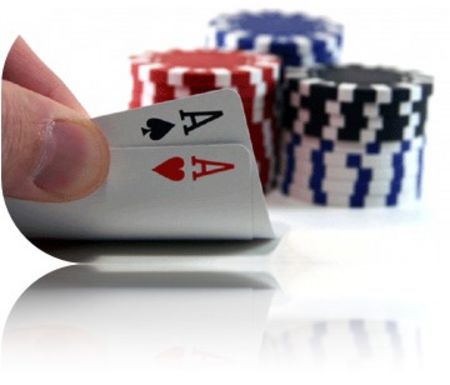All High Cards

You should get a lot of action with two pair and a high card flop. Many opponents
will hold pairs and/or straight draws. Your opponents could flop a straight or a set,
but you should generally play aggressively until your opponents let you know that
you might be beat. Against several opponents, almost always bet out or raise. You
do not want to give a free card and you want to charge your opponents for drawing.
One exception to betting out is trying a check-raise when the pot is large to drive
out players on weak draws such as gut shots.
If you are against a lone opponent, tend to bet out more as opposed to the two-
suited or two-connected flops. Check-raises are risky since many opponents may
not bet in fear of a check-raise and may take a free card with a weak draw. You can
consider waiting to raise the turn if a lone opponent bets into you.
One note about holding the two smallest pair with a high card flop. You should still
play aggressively, but if your opponents start raising and reraising, you may be in
trouble. For example, if you hold KT with a flop of AKT and two opponents are
raising and reraising, you should probably fold. AA, KK, TT, AK, AT, and QJ are all
possible hands that would have you beat.
Rainbow with One High Card
This is a very favorable flop for two pair, although sometimes it is difficult to get a lot
of action. With a large pot, you should bet out, raise, or reraise as usual if given the
opportunity. If an opponent raises with a suspected overpair, you can reraise and
bet out the turn. Check-raising is risky with these types of flops since you hold two
of the board cards in your hand. One exception to raising the flop is when the pot is
very large and you think you have a better chance of driving out opponents on the
turn.
With a small pot, you have a few more options since giving a free card is not as
risky. You have a strong hand and would like to gain more bets. When acting first
against one or two opponents, usually check unless you were the preflop raiser.
Against a preflop raiser, sometimes check-raise and sometimes just check and call
to wait and show your strength on the turn. With more than two opponents, you
should usually go ahead and bet out or raise if given the opportunity.
Rainbow of All Rags
Strategy for a rainbow flop of all rags is very similar to strategy for a flop with only
one high card. The difference is that betting out is not as likely to scare off
opponents since they will often play two overcards. A common situation for flopping
two pair with an all rag flop is when you get a free play out of the blinds. Since it is
difficult for opponents to put you on any kind of hand, you should usually bet out if
your opponents are the type who will call with overcards. If someone raises, you
can decide whether to reraise the flop or wait until the turn to show your true
strength. Be careful however in giving a free card if the pot is large.
If a player bets into you on the flop, then again your options are open. If the pot is
large, usually raise to try and drive out opponents with weak draws. If the pot is
small raising or slowplaying are both good options depending on how your feel you
can extract the most bets from your opponents.
NEXT...Review

